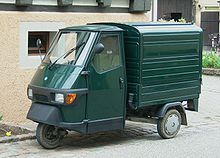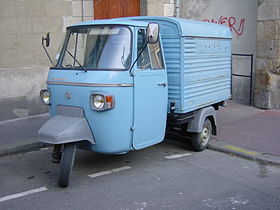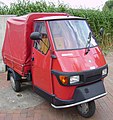|
Piaggio Ape
The Piaggio Ape (pronounced [ˈpjaddʒo ˈaːpe]; ape being Italian for 'bee'),[1][2] initially marketed as VespaCar or TriVespa,[1] is a three-wheeled light commercial vehicle, manufactured and marketed by Piaggio as an adaptation of the company's Vespa scooter (vespa being Italian for 'wasp'). It has been in continuous production since its 1948 introduction and is offered in numerous body configurations, serving a range of utilitarian functions. History and design After World War II, many Italians could not afford personal transportation. In 1947, aircraft designer Corradino D'Ascanio conceived a light and simple three-wheeled commercial vehicle, which found favor with Piaggio. The first model was a cabless adaptation of the company's two-wheel scooter, the Vespa, adding two rear wheels and a flat utility bed over the rear axle. Initial models featured 50 cc,[4] 125 cc or 150 cc engines and, later, a 175 cc engine. By the time of the 1964 Ape D, a cab was added to protect the driver from the elements.[5]  With handlebar steering (a steering wheel became a later innovation), the original Ape was a single-seater that could provisionally accommodate two passengers of modest size. A door was provided on each side, to facilitate entry and exit. Performance was modest, suited to light delivery, with adequate torque for hills and a low top speed. On larger roads, Apes could be driven close to the curb to allow other vehicles to pass.    UsageThe Ape has been marketed in various configurations, including as vans and pickups for load carrying (popular with postal administration in some countries) and as an autorickshaw. More recently Piaggio has offered models such as the Ape Cross Country and the Ape Web aimed at the youth market. The Ape is also commonly used as a promotion tool, with advertising signboards mounted in the load bay. The Ape is common in Italy where its compact size allows it to negotiate narrow streets, park easily, and serve as an impromptu market stall. Most Apes are produced in India by Piaggio India. In India, the Ape is most commonly found in the form of an autorickshaw. A relatively small number of Apes were still made in Italy, but on 16 October 2013, Piaggio announced that Italian production of the Ape would end and construction would move entirely to India.[6] Current modelsCurrently two model ranges are offered: the "Ape 50" with a 49.8 cc petrol engine[7] and the larger "Ape TM" which comes available with a 218 cc petrol engine or a 422 cc diesel engine.[8] The "Ape 50" can carry 175 to 205 kg (386 to 452 lb) while the "TM" and "Classic" can carry 700 to 805 kg (1,543 to 1,775 lb) (depending on version and engine).[9] Fuel consumption for the current Ape 50 model is about 30 km/L (85 mpg‑imp; 71 mpg‑US)[10][11] A limited edition named the Calessino was offered with retro styling in an autorickshaw configuration and two colors white and anniversary blue – the design evoking the Ape of the 1950s and 1960s.[12] A design modified for racing for the Piaggio Ape has been built. The Ape Proto is hand-made and it contains modifications to enable drifting and faster driving. It has been used in special racing competitions, like the Ape RR Show in San Marino.[13] In popular cultureTogether with the Reliant Robin, the Ape was a major inspiration for the Ibishu Pigeon on BeamNG.drive. Model history
Special variants
Gallery
See alsoReferences
External linksWikimedia Commons has media related to Piaggio Ape. |
||||||||||||||||||||||||||||||||||










